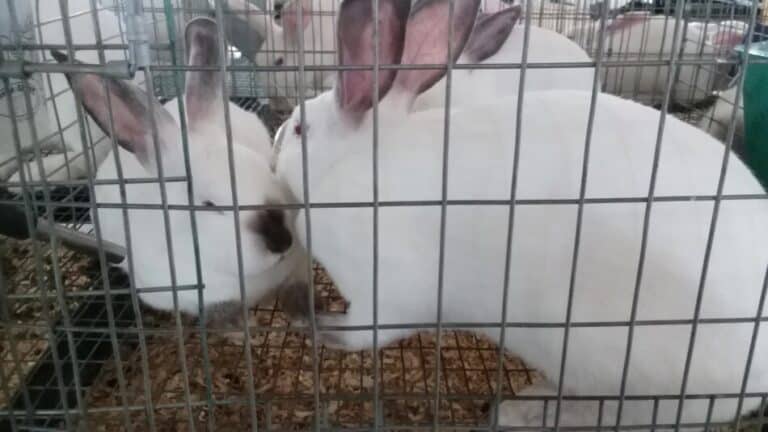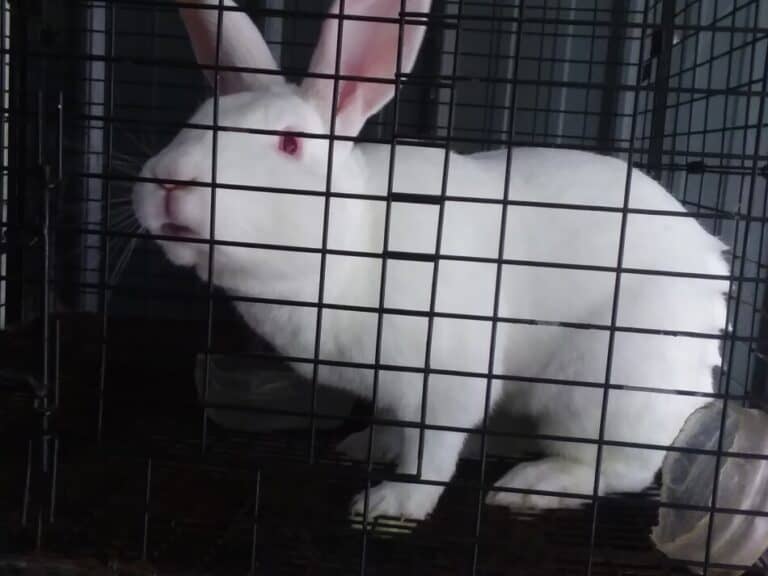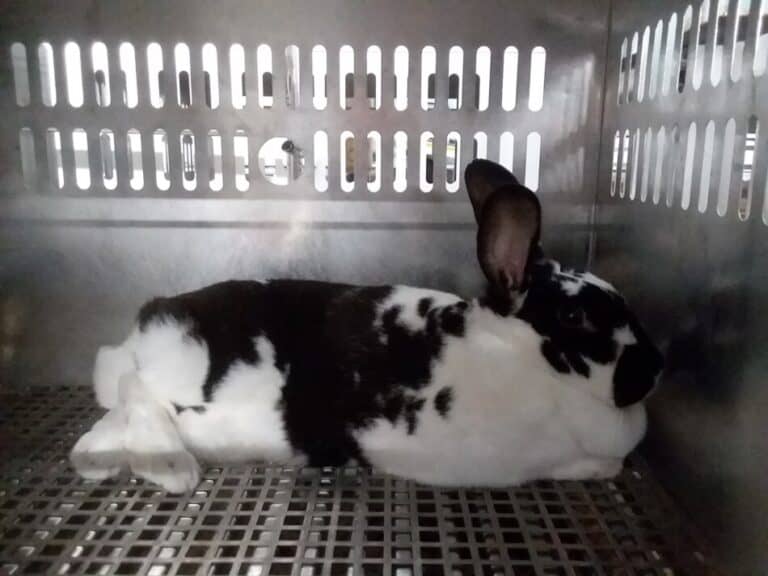16 Breeds Of Rabbits To Raise For Meat
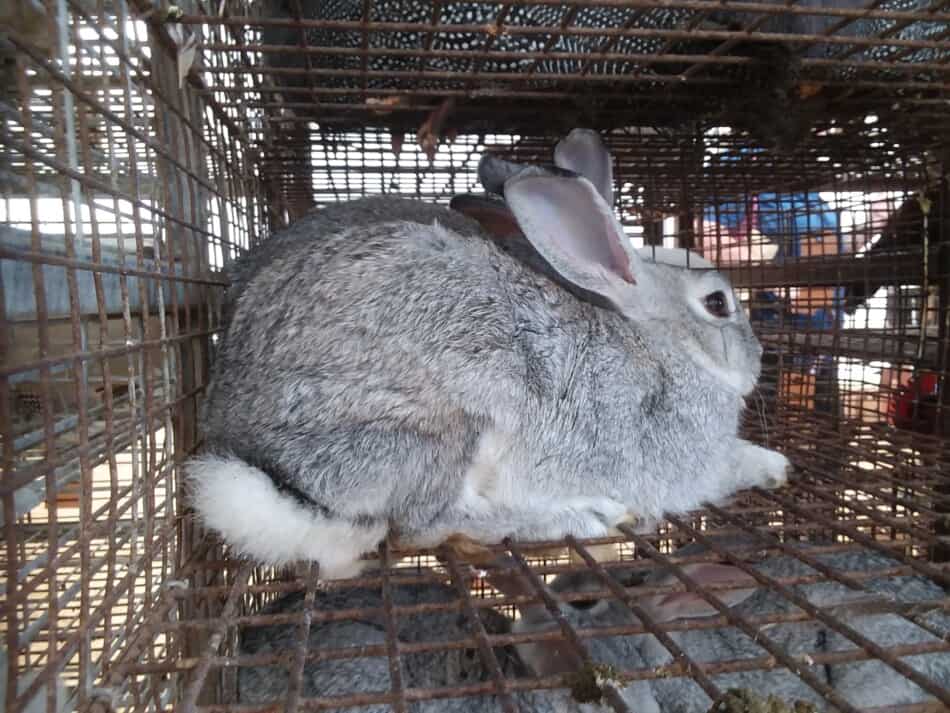
Thinking about raising your own meat rabbits? There is a ton of information available, which can be helpful or confusing!
As a beginner looking to raise rabbits for meat, which breed of rabbits should you choose?
The most popular breeds of rabbits to raise for meat are New Zealand, Californian and Satin.
Less common meat breeds are: American, American Chinchilla, American Sable, Champagne D’Argent, Cinnamon, Creme D’Argent, Harlequin, Hotot, Lilac, Palomino, Rex, Silver Fox and Silver Marten.
Since I have decided to get back into raising meat rabbits, I’ve been scouring the internet to find “the best breed” of meat rabbits for me.
I love looking over breed information and considering the possibilities of what breed I could get!
In fact, I just sent a message to a rabbitry regarding some New Zealand Reds, we’ll see how it shakes out. I’m hopeful!
Getting Started With Meat Rabbits shows you what to expect to pay for a high quality breeding trio and the equipment to care for them and their fryers.
Remember: All rabbits can be raised for meat, but some breeds are much more efficient at using feed and will grow faster for the time you put into them.
This means that there is no “best breed”, but there will be a breed that will suit you the best!
Hopefully, this article will help you narrow down your choices!
Wondering how many rabbits you need for your family? Read my article Number Of Rabbits To Feed A Family Of Four!

New Zealand rabbits are popular
Ease of buying breeding stock: Commonly available rabbits
Mature weight: 12 pounds
Known for: New Zealand rabbits are a meaty and very productive rabbit.
New Zealand rabbits are the top breed for meat production. They produce well in a commercial setting and are the most popular rabbit around the world.
New Zealands are an easy choice for anyone looking to get into raising meat rabbits. There are a variety of colors including Black, Broken (spotted) and Red, in addition to the overwhelmingly popular Ruby Eyed White.
As with all breeds listed here: the specific genetics used by your rabbitry of choice will determine the growth and performance of the rabbits you get.
Not all rabbits, even New Zealands, are the same. Get your stock from a rabbitry with good genetics.
Here is a link to the ARBA listed breed club: American Federation Of New Zealand Rabbit Breeders
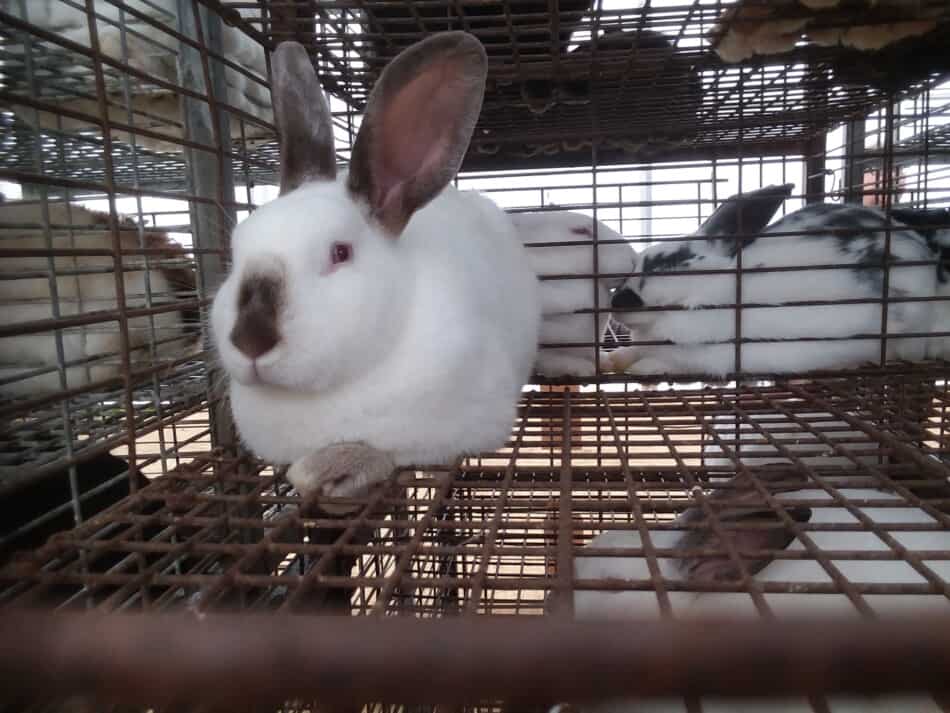
Californians are great meat rabbits
Ease of buying breeding stock: Commonly available rabbits
Mature weight: 10.5 pounds
Known for: Californian rabbits are meaty and have a white body with black points.
Californian rabbits are the second most popular meat rabbit.
They have the same meaty white body you have come to associate with a meat rabbit, but with a twist, black points! In Californian rabbits the ears, nose, tail and feet are black!
Cals (a popular nickname for the breed) are used on their own to produce great fryers and purebred replacement stock.
Additionally, superior growth has been documented when a Cal buck is bred to New Zealand does.
In this cross, you would get the added benefit of hybrid vigor to make the fryers from the New Zealand grow even faster.
Here is a link to the ARBA listed breed club: National Californian Rabbit Specialty Club
Satins are a meat rabbit with sheen
Ease of buying breeding stock: Fairly common rabbits
Mature weight: 11 pounds
Known for: Satins are famous for their sheen.
Satins have more recently been put at the top of the possible market rabbit breeds list, especially for kids looking to take some market rabbits for the county fair.
Satins are unfortunately also known for their beautiful fur and (in some lines) their not so beautiful attitude.
However, they are becoming more commonly available, meaning a good number of rabbit enthusiasts are happy with them.
Lately, I’ve even see them advertised on my local online ads as meat rabbits for 4-H kids.
Many people are raising them and, presumably, liking them, just be aware and be sure to ask your breeder before you buy your rabbits.
Here is the ARBA link to the breed club: American Satin Rabbit Breeders Association
Where do I get this information, since I have never owned any Satins? Check out this video from Sprague River Homestead.
Less common meat rabbit breeds
The rest of the rabbit breeds on this list have a commercial body type and can be raised for meat.
They will not be able to perform and/or produce at the level of the rabbits listed above. However, they will still make good meat rabbits.
If you are looking for the easiest to find and most likely to perform well for you, look to the breeds above.
Starting with one of the more common breeds of rabbits is the most likely path to success for a beginning rabbit raiser.
If you are interested in something a bit different that still has good meat quality, consider one of the breeds below.
American rabbits are friendly
Ease of finding breeding stock: Unusual breed, availability depends upon location
Mature weight: 12 pounds
Known for: Americans are friendly and easy to handle.
The American rabbit is a mandolin shaped rabbit that comes in white or blue. They are know for being friendly and active.
Certain breeding stock lines are capable of very fast growth, check out the video for details.
I have never seen these rabbits myself, but they are frequently showing up in online ads, which tells me a lot of rabbit raisers are looking into Americans and liking what they find.
Here is the ARBA link to the breed club: Breeders Of The American Rabbit NSC

The picture does not do justice to the lovely fur on these rabbits. (And don’t be alarmed about the small cage, they are only in these cages for a few hours.)
The first picture (at the top of the page) is a pair of American Chinchillas, as well.
American Chinchillas are a beautiful silver
Ease of finding breeding stock: Less common breed, availability of breeding stock will depend upon location
Mature weight: 12 pounds
Known for: American Chinchilla rabbits are famous for their fur.
The American Chinchilla is an interesting breed in that it was crazy popular in the 1920’s when the fur industry was booming.
Why? American Chinchillas were bred to be a cheaper more readily available “look alike” fur to replace the high demand furs for the Chinchilla (small rodent with big eyes squirrel type tail).
Once the fur industry fell apart, so did the demand for these rabbits. Sad, because they are such a sharp looking, meaty rabbit!
Here is the ARBA link to the breed club: American Chinchilla Rabbit Breeders Assoc.
A note on Giant Chinchilla rabbits: these are a cross between an American Chinchilla and a Flemish Giant.
These rabbits will have quite a bit of size to them that is a high proportion bone, meaning they will not be an efficient meat rabbit.
American Sables have mink like fur
Ease of finding breeding stock: Challenging to locate rabbits, try the Livestock Conservancy breeder’s list
Mature weight: 9 pounds
Known for: American Sable’s are famous for their mink like fur.
I have never seen an American Sable or been able to find out much about them. That’s unfortunate, since they seem like a neat rabbit breed.
Check out this article on the American Sable by The Livestock Conservancy for breed information.
Here is the ARBA link to the breeders club: American Sable Rabbit Society
Blanc de Hotot are unusual rabbits
Ease of finding breeding stock: Unusual breed, Hotot’s are going to be hard to find
Mature weight: 11 pounds
Known for: Hotot’s are known for their pure white paired with black rimmed eyes.
Hotot is pronounced “Oh-toe”. Hotots are another French meat breed easily recognized by their white bodies and black encircled eyes.
The Hotot’s black eye rim reminds me of Cleopatra style eyeliner!
This is one of the rarer breeds on the list, but worth checking into if you are interested in an unusual meat breed.
Here is the ARBA link to the breed club: Hotot Rabbit Breeders International
Hotot are another breed that have a Mini counter part that, at least to me, is much more common. I’m pretty sure I have seen the Mini Hotot at our local fair!
Champagne D’Argent are becoming more popular
Ease of finding breeding stock: Less common breed, availability depends upon location
Mature weight: 12 pounds
Known for: Champagne’s are well known for their meat to bone ratio.
The Champagne D’Argent has become more popular recently.
They are known for having great muscling with smaller bone structure, meaning you get more meat on the fryer.
I have always been intrigued by the coloring of these rabbits. They are born dark and then start to get the “frosted” coloring as they age.
Champagne’s are showing up on Craigslist ads here (Ohio) fairly regularly.
Here is the ARBA link to the breed club: Champagne d’Argent Rabbit Federation
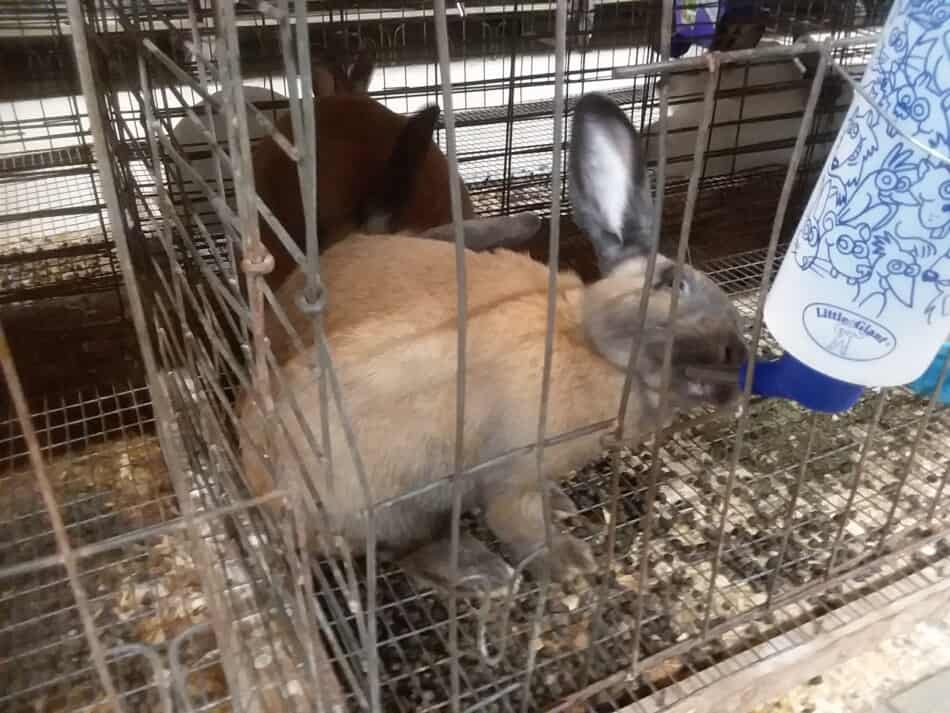
Cinnamon rabbits all have the same color pattern
Ease of finding breeding stock: Less common breed, availability depends upon location
Mature weight: 11 pounds
Known for: Cinnamon rabbits are known for their brown tipped coloration.
Cinnamons are a much less common rabbit than many of the other on the list. Cinnamons are tan with brown points, like a Siamese cat.
This is a relatively new breed that is located in pockets of breeders scattered through out the county.
They look like a great rabbit to me, but I have never seen one or talked to anyone who raises them, so my information regarding their normal growth and performance is very limited.
Here is the ARBA link to the breed club: Cinnamon Rabbit Breeder’s Assoc.
Creme D’Argents have unusual coloring
Ease of finding breeding stock: Unusual breed, will be challenging to locate
Mature weight: 11 pounds
Known for: Creme’s are one section of the Argent breed of rabbits, famous for their meat qualities.
Creme D’Argent are one of the colorings of the the Argent rabbits, like the Champagne D’Argents. The Cremes are a lighter rabbit with the same “frosted” coloring as the rest of the Argents.
Currently, the Cremes are a little less popular than the Champagnes, but have many of the same attributes.
Here is the ARBA link to the breed club: Creme d’Argent Rabbit Federation
I had trouble finding much data on growth of Creme’s. They are beautiful rabbits! Be sure to ask about meat rabbit characteristics when you buy.
(Check out the last section of this article for questions to ask the breeder.)
Harlequin rabbits are a marked breed
Ease of finding breeding stock: Less common breed, seems to be raised in pockets
Mature weight: 9.5 pounds
Known for: Harlequin rabbits are known for their striking color pattern.
Harlequins are an interesting rabbit that actually started off as an off shoot of the Dutch rabbit. Crazy, since Dutch rabbits are so much smaller!
The big “thing” with the Harlequin rabbits is their color pattern and markings. While Harlequins are a meat breed, some breeders focus mostly on coloration.
There are two color groups, the Japanese and the Magpie. Japanese colored Harlequins will have orange and black coats. Magpie will have another color (usually white) and black in their coats.
Since Harlequins are a marked breed, be sure to ask about weights and check for meatiness in the adults before you buy.
Good sized Harlequins are around! Keep looking if the first breeder you find doesn’t have the conformation you are looking for.
Here is the ARBA link to the breed club: American Harlequin Rabbit Club
Lilacs are a smaller, meaty rabbit
Ease of finding breeding stock: Less common breed, but spread throughout the country
Mature weight: 8 pounds
Known for: Lilac’s are friendly, mid size rabbits that are great for kids.
The Lilac is a bit smaller of a breed than some of the others on the list. If you are looking for a meat rabbit with a bit less size as an adult, the Lilac may be just what you are looking for.
Why want a smaller rabbit? The easy answer is kids. Some of the larger rabbits on this list are going to be a bit unruly for kids to handle.
Also, not all of the rabbits used for meat production have good attitudes. Another challenge for anyone wanting to get the kids involved.
Lilacs are a bit smaller, have an interesting color and have wonderful personalities making them ideal for kids.
Here is the ARBA link to the breed club: National Lilac Rabbit Club Of America
Palomino rabbits have two colors
Ease of finding breeding stock: Less common rabbit, availability varies by location
Mature weight: 11 pounds
Known for:
Palomino is a golden, lesser known meat rabbit breed. They were developed in American in the 1920’s to be raised as a meat rabbit.
The Pals (as they are affectionately called) also come in a black tipped gold color, which is called Lynx.
This is another rabbit breed that seems very interesting to me, but I have never had the chance to see one or ask breeders about them.
Here is the ARBA link to the breed club: Palomino Rabbit CoBreeders Association
Rex rabbits have color varieties
Ease of finding breeding stock: Fairly common breed
Mature weight: 10.5 pounds
Known for: Rex rabbits are known for their short, wonderfully soft fur.
Of all of the lesser known meat rabbit breeds, the Rex is the one I see the most of online, in videos especially.
I really like the look and feel of their fur, such a wonderful texture!
I also have to admit, I like the color variety available.
If you had a few differently colored rabbits, it would give you a bit of a surprise each time a litter was born!
You’d never know what interesting colors could show up in that nest box!
Here is the ARBA link to the breed club: National Rex Rabbit Club
Silver Fox are rising in numbers
Here is an interview with a Silver Fox rabbit raiser in a video put together by my favorite rabbit information channel, Sprague River Homestead.
If you are interested in rabbits and have not checked out this channel yet, you should! Tons of great rabbit info!
Ease of finding breeding stock: Unusual breed, generally challenging to find but is gaining popularity
Mature weight: 12 pounds
Known for: Silver Fox rabbits are known for their fur, which stands upright.
Silver Fox was an endangered breed that has made a great recovery! They are an up and coming meat rabbit with a wonderful attitude.
I have never raised these rabbits, but I see the draw to them. I’ve also noticed that Silver Fox rabbits seem to be the breed of choice for many homesteaders with video channels.
Here is the ARBA link to the breed club: National Silver Fox Rabbit Club
Silver Martens are have 4 beautiful colors
Ease of finding breeding stock: Less common breed, more rabbits seem to be available in the eastern half of the U.S.
Mature weight: 9.5 pounds
Known for: The Silver Marten is known for it’s four beautiful colors.
I have not seen these great rabbits in person, but love their look! Here is a link to The Livestock Conservancy article that explains more about the Silver Marten Rabbit.
Here is the ARBA link to the breed club: Silver Marten Rabbit Club
Breeds that did not make the list
Some rabbit breeds that would be thought of as meat breeds are not included on this list. Two easy examples are Flemish Giants and Florida Whites.
Ironically, these two breeds that are so very different both have the same reason for being left off the list: size.
The Florida Whites are small and the Flemish Giants, as you may have guessed, are very large, but both are not what would be considered meat rabbit size.
Both of these breeds and many others left off the list are not bred for meat production qualities. Meat breed rabbits will be efficient growers and the best use of your time and cage space.
If you are interested in another rabbit breed, please look into it. After all, the main person to please here is you!
3 questions you should ask before you buy your meat rabbits!
Since I am looking for meat rabbits, I ask the rabbitry owner a few questions regarding growth and performance of these genetics.
Specifically:
- How many weeks until the fryers (young rabbits) are 5 pounds?
- What is your average number of kits (baby rabbits) per litter?
- How is the attitude of these rabbits?
Here are the stats that I am looking for:
- Fryers that are 5 pounds by 10 weeks (sooner would be better, of course!)
- An average litter size of 8
- Good attitude (no aggressive behavior)
There are no right or wrong answers here, these are just the numbers and genetics that I am hoping to find. You need to decide what numbers you are shooting for based on what is important to you.
You need to come up with your own questions, or use these! Either way, ask about the growth and litter sizes that the rabbitry normally gets.
When you ask about rabbits, if you are happy with the answers you get, super! If not, thank them for their time and look for different rabbits.
Please note: really large litters will take longer to reach 5 pounds and unusually small litters will be fast (this is why you need to ask about average number of kits).
Also, rabbits fed anything other than pellets (like grass or hay) will also be slower growing.

